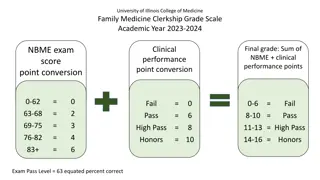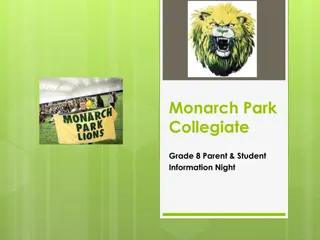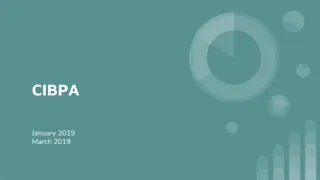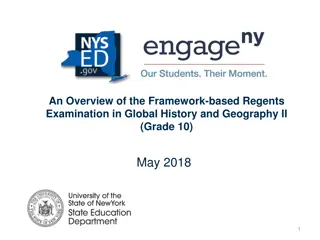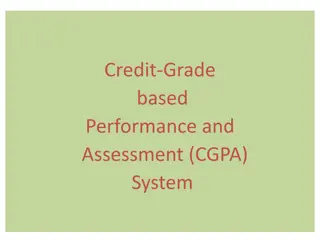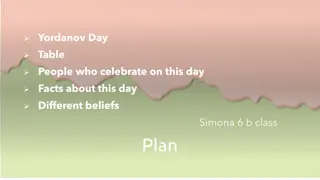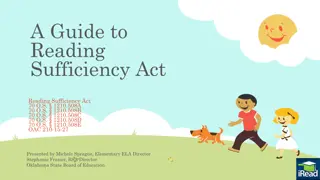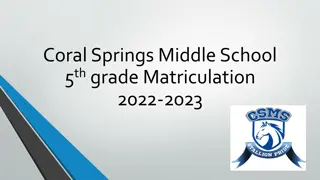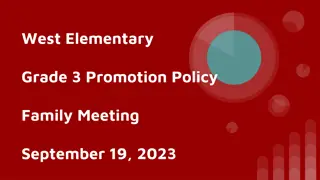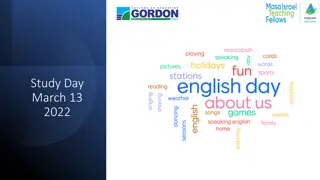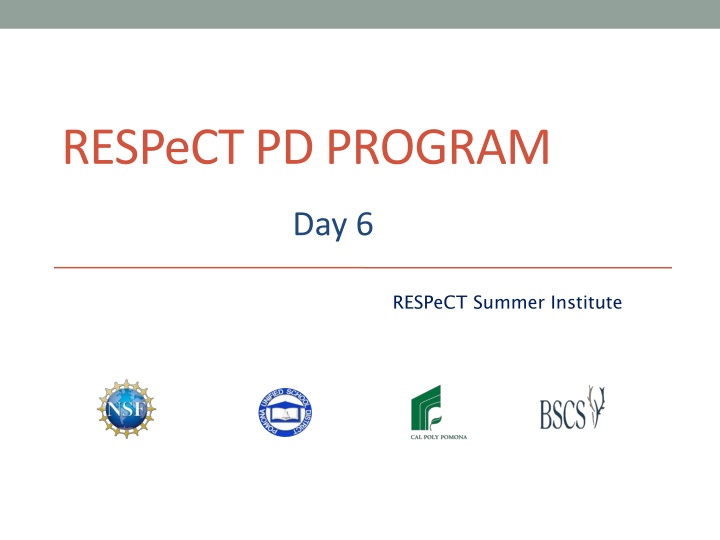
Enhancing Science Content Storyline Coherence Through Effective Teaching Strategies
Explore the RESPeCTPD PROGRAM Day 6 agenda focusing on enhancing science content storyline coherence. Discover insights on lesson analysis, STELLA strategies, trait variations in plants and animals, and more to help students develop a coherent science narrative.
Download Presentation

Please find below an Image/Link to download the presentation.
The content on the website is provided AS IS for your information and personal use only. It may not be sold, licensed, or shared on other websites without obtaining consent from the author. If you encounter any issues during the download, it is possible that the publisher has removed the file from their server.
You are allowed to download the files provided on this website for personal or commercial use, subject to the condition that they are used lawfully. All files are the property of their respective owners.
The content on the website is provided AS IS for your information and personal use only. It may not be sold, licensed, or shared on other websites without obtaining consent from the author.
E N D
Presentation Transcript
RESPeCTPD PROGRAM Day 6 RESPeCT Summer Institute
Agenda for Day 6 Day-5 reflections Review: science content storyline Today s focus questions Lesson analysis: STeLLA strategies B, I, and 7 Content deepening: variations in plants and animals Lunch Content deepening (continued) Lesson analysis: SCSL strategy C Summary, homework, and reflections
Trends in Reflections Lesson Analysis Science Content Learning
Review: Science Content Storyline In your notebooks, jot down 3 things you remember from yesterday s session, 2 ideas that seem important to you, and 1 question you have. Be prepared to share one idea and question with the group.
Todays Focus Questions How can we begin and end a lesson to help students develop a coherent science content storyline? How can selecting appropriate science activities help students develop a coherent science content storyline? How can trait variations affect which plants or animals of the same kind survive long enough to reproduce?
Lesson Analysis: Focus Question 1 How can we begin and end a lesson to help students develop a coherent science content storyline?
Strategies B, I, and 7: Purposes and Key Features Group 1: What are the purpose and key features of strategy B? Why is a focus question or goal statement important for science content storyline coherence? Group 2: What are the purpose and key features of strategy I? Why is summarizing key science ideas important for science content storyline coherence? Group 3: What are the purpose and key features of strategy 7? How does strategy 7 compare with strategy I? All groups: Make sure to cite ideas from the STeLLA strategies booklet in your answers.
Discussion Questions: Strategy B 1. What is the difference between focus questions and goal statements? 2. Which do you think would be more useful in engaging student interest and making their thinking visible focus questions or goal statements?
Discussion Questions: Strategies I and 7 1. What are various ways a lesson or unit can be synthesized and/or summarized? 2. How are strategies I and 7 similar and different? a. SCSL strategy I: Summarize key science ideas. b. STL strategy 7: Engage students in making connections by synthesizing and summarizing key science ideas.
Video-based Lesson Analysis Next we ll analyze a video clip from the beginning and end of a lesson on variations in plants and animals.
Lesson Analysis: Strategy B 1. In Analysis Guides B and I (handout 6.1), review the four criteria for strategy B: Setting the purpose. 2. Read the lesson context at the top of the video transcript (handout 6.2). 3. Watch the video clip, keeping in mind the criteria for strategy B. 4. Analyze the transcript using the analysis guide. How well does the beginning of this lesson match the criteria for strategy B? 5. Share and compare your analyses. Link to video clip 1: 6.1_mspcp_gr.1.tav_bernstein_L1_c2
Lesson Analysis: Strategy I 1. In Analysis Guides B and I (handout 6.1), review the six criteria for strategy I: Summarizing key science ideas. 2. Review the lesson context at the top of the video transcript (handout 6.3). 3. Watch the video clip, keeping in mind the criteria for strategy I. 4. Analyze the transcript using the analysis guide. How well does the end of this lesson match the criteria for strategy I? 5. Share and compare your analyses. Link to video clip 2: 6.2_mspcp_gr.1.tav_bernstein_L1_c3
The VPA Lesson Plans: Reading and Analysis 1. Examine the main learning goal, the lesson focus question, and the lesson summary for your assigned VPA lesson plan (parts A and B). 2. Answer these questions in your notebooks, keeping in mind the analysis-guide criteria for strategies B and I: What do you notice? What do you wonder about?
VARIATIONS IN PLANTS AND ANIMALS SCIENCE CONTENT DEEPENING Grade 1
Unit Central Question How do differences (variations) in plants or animals of the same kind help them survive so they can produce young (babies or seeds)? Photo courtesy of Pexels.com
Review Focus questions from our last session: How do traits of living things help us understand how they re grouped and related? Why are trait variations important for the survival of living things? How can we represent patterns of trait variation among individuals of a species?
Key Science Ideas Plants or animals of the same group share similar characteristics or traits that we can recognize. Plants or animals of the same group also have variations in traits that can help them survive. Some traits in plants or animals of the same kind can be measured, and we can use these measurements to confirm how much variation exists in a trait. Patterns of trait variation among individuals of a species can be represented in different ways, such as on frequency distribution tables and histograms.
Role-Play: VPA Lesson 1 1. Pair up and decide who will be Teacher 1 and Teacher 2 for this role-play. 2. Teacher 1: Review lessons 1a and 1d, select a 7- minute segment from one lesson to teach, and gather the necessary materials listed on the overview page. 3. Teacher 2: Review lessons 1b and 1c, select a 7- minute segment from one lesson to teach, and gather the necessary materials. 4. If you aren t the one teaching, you ll be the student.
Role-Play: VPA Lesson 1 1. Prepare for the role-play: Student role: Review the Common Student Ideas document (resources section of binder) and be ready to use these ideas when you re the student. Teacher role: Review the anticipated student responses and practice asking each other elicit and probe questions. 2. Act out the role-play with your partner; then switch roles.
Review: VPA Lesson 1 1. In what ways did the activity in each lesson (1a d) align with the corresponding focus question(s)? 2. How well matched were the activity and main learning goal in each lesson? 3. What strategies are used to help students summarize the key ideas in each lesson? 4. How well does the content in each lesson align with the content deepening work from last time? 5. What level of life (biology) varied in each lesson?
Role-Play: VPA Lesson 2 1. Pair up and decide who will be Teacher 1 and Teacher 2 for this role-play. The person not teaching will be the student. 2. Teacher 1: Review lesson 2a select a 10-minute segment to teach, and gather the materials. 3. Teacher 2: Review lesson 2b, select a 10-minute segment to teach, and gather the materials. 4. Students: Come up with 3 challenge questions the teacher might ask to move your thinking forward. 5. Practice asking each other elicit, probe, and challenge questions. 6. Act out the role-play; then switch roles.
Review: VPA Lesson 2 1. In what ways did the activity in each lesson (2a and 2b) align with the corresponding focus question(s)? 2. How well matched were the activity and main learning goal in each lesson? 3. What strategies are used to help students summarize the key ideas in each lesson? 4. How well does the content in each lesson align with the content deepening work from last time?
Common Core Math Standards Order three objects by length; compare the lengths of two objects indirectly by using a third object (1.MD.A.1) Express the length of an object as a whole number of length units, by laying multiple copies of a shorter object (the length unit) end to end; understand that the length measurement of an object is the number of same-size length units that span it with no gaps or overlaps. Limit to contexts where the object being measured is spanned by a whole number of length units with no gaps or overlaps. (1.MD.A.2) Organize, represent, and interpret data with up to three categories; ask and answer questions about the total number of data points, how many in each category, and how many more or less are in one category than in another. (1.MD.C.4)
Math Connections! Read through supplemental math lessons 1 and 2 in your lesson plans binder. Then answer these questions in your science notebooks: What activity do students engage in? What materials are needed for this activity? How well does the activity fit the unit central question? How is the activity relevant to the math concepts your 1st graders learn about?
Lets Summarize! Read section 3 (Variation in Traits) in the content background document. Write a sentence in your notebook summarizing key ideas from the reading. Be prepared to share your summary statement with the group.
Content Deepening Focus Question How can trait variations affect which plants or animals of the same kind survive long enough to reproduce?
Lesson-3 Focus Questions Will bigger or smaller cottonwood-tree seeds be more likely to survive and grow when the wind carries them away? Why do you think so?
What Is a Cottonwood Tree? Photograph by George Chernilevsky/Wikimedia Commons Photograph by Amy Gaiennie/Wikimedia Commons
Cottonwood Seeds Blowing in the Wind Let s watch a short video clip of cottonwood- tree seeds blowing in the wind. Photograph by George Chernilevsky/Wikimedia Commons Link to video clip: https://youtu.be/9Cgvjm04EVg
Cottonwood-Seed Model What does the fan represent? What do the cotton balls represent? What does the paper on the floor represent? What does the line on the paper marked Tree represent? Photo courtesy of BSCS
What Do You Think Will Happen? Will the bigger or smaller cotton balls (cottonwood seeds) travel farther when the wind blows them? Why do you think so? Write your predictions in your notebook using this sentence starter: I predict the [bigger or smaller] cotton balls will travel farther on the wind because
How Far Will the Cotton Balls Fly? Photo courtesy of BSCS
Reflect: Lesson-3 Focus Questions Lesson-3 focus questions: Will bigger or smaller cottonwood-tree seeds be more likely to survive and grow after the wind carries them away? Why do you think so? Think about the results of our investigation. Then complete this sentence in your science notebook: I think [bigger or smaller] cottonwood-tree seeds are more likely to survive and grow into new cottonwood trees because
Lesson-4 Focus Question What helps some cottonwood-tree seeds survive and grow while other seeds don t?
Where Will the Cottonwood Seeds Land? Which of the cottonwood-tree seeds will land in a place where they can survive and grow into new cottonwood trees? Why?
Reflect: Lesson-4 Focus Question What helps some cottonwood-tree seeds survive and grow while other seeds don t?
Reflect: Content Deepening Focus Question How can trait variations affect which plants or animals of the same kind survive long enough to reproduce?
Lesson Analysis: Focus Question 2 How can selecting appropriate science activities help students develop a coherent science content storyline?
Strategy C: Purpose and Key Features According to the strategies booklet, what are the purpose and key features of strategy C: Select activities that are matched to the learning goal?
Lesson Analysis Question Main learning goal: Plants or animals of the same group share similar characteristics or traits that we can recognize. They also have variations in traits that help them survive. Focus questions: How are sunflowers alike and different? What traits and variations do they have? Analysis question: Is the activity well matched to the main learning goal?
Lesson Analysis: Strategy C 1. Write this main learning goal at the top of Analysis Guide C (handout 6.4): Plants or animals of the same group share similar characteristics or traits we can recognize. They also have variations in traits that help them survive. 2. For this analysis, we ll watch three video clips from the same VPA lesson. 3. Before each clip: Read the lesson context at the top of the corresponding video transcript. 4. After each clip: Complete part 1 of the analysis guide. Links to video clips: 6.3_mspcp_gr.1.tav_bernstein_L2_c2; 6.4_mspcp_gr.1.tav_bernstein_L2_c3; 6.5_mspcp_gr.1.tav_bernstein_L2_c4
Lesson Analysis: Strategy C Discuss these questions with a partner: 1. Were the activities well matched to the learning goal? Provide evidence to support your response. 2. Suggest ways to improve the match between the activities and the main learning goal (part 2, Analysis Guide C). Be prepared to share your ideas in a group discussion.
Lesson Analysis: Strategy C Study the video transcripts again and gather evidence to answer these questions: What kept students focused on the main learning goal? What distracted students from the learning goal?
Practice: Strategy C Main learning goal: Plants or animals of the same group share similar characteristics or traits we can recognize. They also have variations in traits that help them survive. Candidate activities: 1. Students draw a monster. Then they compare their drawings and group them according to similarities. 2. Students bring pictures of their pets to class and identify similarities and differences among them. Questions: How well does the activity match the main learning goal? How might the activity be changed to better match the main learning goal?
Todays Focus Questions How can we begin and end a lesson to help students develop a coherent science content storyline? How can selecting appropriate science activities help students develop a coherent science content storyline? How can trait variations affect which plants or animals of the same kind survive long enough to reproduce?
Summarize Todays Work Hold up three fingers when you have all of these in mind: 1. One idea you re taking away about strategy C: Select activities that are matched to the learning goal 2. One idea you re taking away about strategies B, I, and 7: Set the purpose with a focus question or goal statement (strategy B) Summarize key science ideas (strategy I) Engage students in making connections by synthesizing and summarizing key science ideas (strategy 7) 3. One science idea about variations that you re taking away from today s content deepening work.
Homework In the STeLLA strategies booklet, read about SCSL strategy D: Select content representations and models matched to the learning goal and engage students in their use. Fill in the appropriate column on your SCSL Z-fold summary chart.



